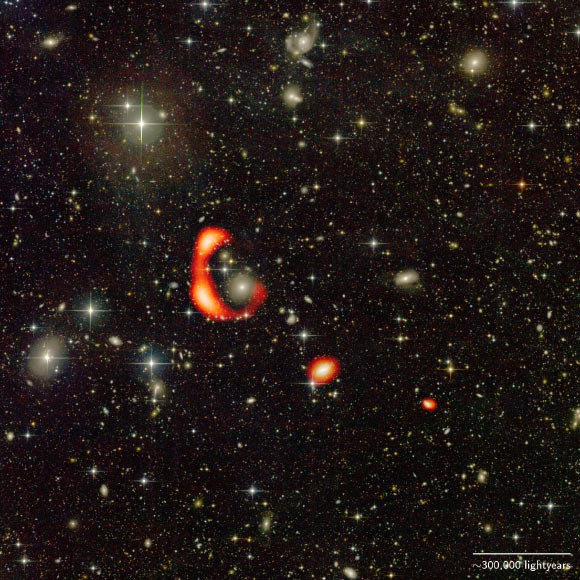Enormous Ring of Neutral Hydrogen Found around Distant Massive Galaxy | Astronomy – Sci-News.com
Astronomers using the Giant Metrewave Radio Telescope (GMRT) have discovered an extremely large off-centered ring of neutral hydrogen gas around AGC 203001, a massive galaxy located 260 million light-years away from Earth.

This CFHT image shows a huge ring of neutral hydrogen gas (red) around the galaxy AGC 203001. The two small red blobs show the distribution of neutral hydrogen around two other galaxies. Image credit: Omkar Bait, NCRA-TIFR & GMRT / Pierre-Alain Duc, ObAS & CFHT.
“Neutral hydrogen gas emits radio waves at a wavelength of about 21 cm,” said Omkar Bait from the National Centre for Radio Astrophysics at India’s Tata Institute of Fundamental Research and his colleagues.
“Typically, large reservoirs of neutral hydrogen are found in galaxies which are actively forming new stars.”
“Despite showing no signs of active star formation, AGC 203001 was known to have large amounts of hydrogen, although its exact distribution was not known.”
“The unusual nature of this galaxy motivated us to use the GMRT to conduct high-resolution radio observation of this galaxy to find out where this gas lies.”
The astronomers found that neutral hydrogen gas in AGC 203001 is distributed in the form of a large ring around it, with a diameter of about 380,000 light-years.
Such an extended structure of neutral hydrogen is very rare with only one other case known so far — the Leo Ring.
“More puzzlingly, we found that the existing optical images of the ring showed no sign of it containing stars,” the researchers said.
They also used the Canada-France-Hawaii-Telescope (CFHT) to observe AGC 203001’s ring in visible wavelengths.
“However, even CFHT images do not show any sign of starlight associated with the hydrogen ring,” Bait and colleagues noted.
“There is no clear answer today as to what could lead to the formation of such large, starless rings of hydrogen,” they added.
“Conventionally, galaxy-galaxy collisions were thought to lead to the formation of such off-centered rings around galaxies.”
“However, such rings also generally contain stars. This is contrary to what is found in AGC 203001’s ring.”
“In the future, we hope to increase the number of such extended neutral hydrogen structures by mapping more galaxies found using our criteria that can help in understanding their formation scenario,” the scientists concluded.
A paper on the discovery will be published in the Monthly Notices of the Royal Astronomical Society.
_____
Omkar Bait et al. 2020. Discovery of a large Hi ring around the quiescent galaxy AGC 203001. MNRAS 492 (1): 1-7; doi: 10.1093/mnras/stz2972





